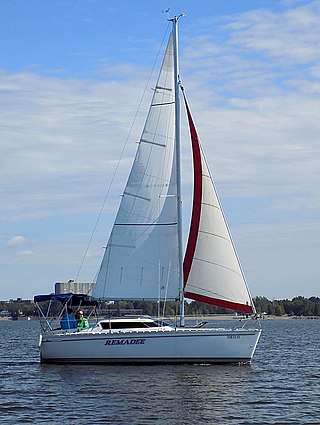Related Research Articles

The Tonic 23 is a French trailerable sailboat, that was designed by Philippe Harlé as a coastal cruiser and first built in 1985.

The Marshall 22 is an American sailboat that was designed by Breckenridge Marshall as a cruiser and first built in 1965.
The Beachcomber 25 is an American trailerable sailboat that was designed by Walter Scott as a cruiser and first built in 1979.
The Cape Cod Cat, also called the Cape Cod Cat 17 and the Hermann Cat, is an American trailerable sailboat that was designed by Charles Whittholz as a day sailer/cruiser and first built in 1968.
The Com-Pac Horizon Cat, also called the Horizon Cat 20, is an American trailerable sailboat that was designed by Halsey Herreshoff as cruiser and first built in 2002.
The Freedom 21 is an American trailerable sailboat that was designed by Gary Hoyt and first built in 1982. It was available as a catboat or sloop rig.
The Hermann 22, also called the Hermann 20 for its waterline length, is an American trailerable sailboat that was designed by Richard P. Ketcham Jr. as a cruiser and first built in 1961.
The Herreshoff America, also called the Herreshoff America 18, is an American trailerable sailboat that was designed by Halsey Chase Herreshoff as a cruiser and first built in 1971.
The MacGregor 19, also called the PowerSailer 19, is an American trailerable sailboat that was designed by Roger MacGregor as a cruiser and first built in 1992.
The Sanderling 18, also called the 18' Sanderling, Marshall Sanderling and just the Sanderling, is an American trailerable sailboat that was designed by Breckenridge Marshall as a daysailer and cruiser and first built in 1962. It is named for the shore bird.
The Menger Cat 17 is an American trailerable sailboat that was designed by Andrew Menger as a daysailer and cruiser and first built in 1983.
The Menger Cat 19, also sold as the Thom Cat 19 Catboat, is an American trailerable sailboat that was designed by father and son team Bill Menger and Andrew Menger as a daysailer and cruiser and first built in 1990.
The Nimble 25 Arctic, also called just the Nimble 25, is an American trailerable sailboat that was designed by Ted Brewer as a cruiser and first built in 1988.
The O'Day 20 is an American trailerable sailboat that was designed by John Deknatel of C.R. Hunt & Associates as a pocket cruiser and first built in 1973.
The O'Day 222 is an American trailerable sailboat that was designed by C. Raymond Hunt Associates as a cruiser and first built in 1984.
The Pearson 23C is an American trailerable sailboat that was designed by William Shaw as a cruiser and first built in 1983.
The Pearson 23 is an American trailerable sailboat that was designed by William Shaw as a cruiser and first built in 1978.
The Mustang 22 is an American trailerable sailboat that was designed by Martin Bludworth as a Midget Ocean Racing Club racer and first built in 1969.
The Seaward 23 is an American trailerable sailboat that was designed by Nick Hake as a pocket cruiser and first built in 1984.
The Slipper 17 is an American trailerable sailboat that was designed by Nick Hake as a pocket cruiser and first built in 1981.
References
- 1 2 3 4 5 6 7 McArthur, Bruce (2020). "Mystic Catboat 20 sailboat". sailboatdata.com. Archived from the original on 22 August 2021. Retrieved 22 August 2021.
- 1 2 3 4 5 6 7 8 9 Henkel, Steve: The Sailor's Book of Small Cruising Sailboats, page 112. International Marine/McGraw-Hill, 2010. ISBN 978-0-07-163652-0
- ↑ McArthur, Bruce (2021). "LBI (USA)". sailboatdata.com. Archived from the original on 22 August 2021. Retrieved 22 August 2021.
- ↑ LBI Corporation Inc (2021). "Innovative Marine Solutions". lbicorp.com. Archived from the original on 22 August 2021. Retrieved 22 August 2021.